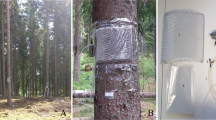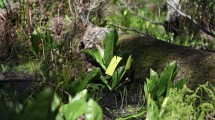Abstract
Dimethyl disulfide (DMDS) was identified as a major volatile constituent of Brassica napus roots heavily infested by Delia radicum, the cabbage root fly. Attractiveness of this widespread compound was tested in the field in a naturally complex odorous environment. By using an original setup especially designed for ground dwelling beetles, different concentrations of the pure molecule as well as attractiveness of the natural blend emitted by the rotten part of infested roots were tested simultaneously. The use of general linear model (GLM) statistics permitted us to finely discriminate the responses among the different treatments. The main predators of D. radicum (i.e., two staphylinids Aleochara bilineata and Aleochara bipustulata and carabid beetles of the genus Bembidion) were significantly attracted by DMDS, but responded in different ways to the natural blend and to the different concentrations tested. The dose–response curves were similar for the two staphylinids. However, whereas A. bilineata was more attracted by the natural volatile blend than by its preferred DMDS concentration, A. bipustulata was attracted as much by the natural blend as by its preferred DMDS concentration. Carabid beetles exhibited a different response. They were not attracted by the natural blend, but responded to a wider range of DMDS concentrations that included low concentrations that did not attract the staphylinid beetles. These results are discussed according to the potential resources searched by each taxon studied and their specificity for the resources. The possible use of DMDS for enhancing biological control of D. radicum is mentioned.





Similar content being viewed by others
References
Ahlström-Olsson, M., and Jonasson, T. 1992. Mustard meal mulch—a possible cultural method for attracting natural enemies of brassica root flies into brassica crops. IOBC/WPRS Bull. 15:171–175.
Auger, J., Lecomte, C., Paris, J., and Thibout, E. 1989a. Identification of leek-moth and diamondback-moth frass volatiles that stimulate parasitoid, Diadromus pulchellus. J. Chem. Ecol. 15:1391–1398.
Auger, J., Lecomte, C., and Thibout, E. 1989b. Leek odor analysis by gas-chromatography and identification of the most active-substance for the leek moth, Acrolepiopsis assectella. J. Chem. Ecol. 15:1847–1854.
Becker, R. A., Chambers, J. M., and Wilks, A. R. 1988. The New S Language. Wadsworth & Brooks/Cole.
Bell, W. J. 1990. Searching behavior patterns in insects. Annu. Rev. Entomol. 35:447–467.
Bernays, E. A. 1996. Selective attention and host-plant specialization. Entomol. Exp. Appl. 80:125–131.
Bukovinszky, T., Gols, R., Posthumus, M. A., Vet, L. E. M., and Van Lenteren, J. C. 2005. Variation in plant volatiles and attraction of the parasitoid Diadegma semiclausum (Hellen). J. Chem. Ecol. 31:461–480.
Coaker, T. H. and Williams, D. A. 1963. The importance of some carabidae and staphylinidae as predators of the cabbage root fly, Erioischia brassicae (Bouché). Entomol. Exp. Applicata 6:156–164.
D’Alessandro, M. and Turlings, T. C. J. 2006. Advances and challenges in the identification of volatiles that mediate interactions among plants and arthropods. Analyst 131:24–32.
De Boer, J. G. and Dicke, M. 2004. The role of methyl salicylate in prey searching behavior of the predatory mite Phytoseiulus persimilis. J. Chem Ecol. 30:255–271.
De Boer, J. G. and Dicke, M. 2006. Olfactory learning by predatory arthropods. Anim. Biol. 56:143–155.
De Moraes, C. M., Lewis, W. J., Pare, P. W., Alborn, H. T., and Tumlinson, J. H. 1998. Herbivore-infested plants selectively attract parasitoids. Nature 393:570–573.
Dicke, M., Sabelis, M. W., Takabayashi, J., Bruin, J., and Posthumus, M. A. 1990a. Plant strategies of manipulating predator–prey interactions through allelochemicals—prospects for application in pest control. J. Chem. Ecol. 16:3091–3118.
Dicke, M., Vanbeek, T. A., Posthumus, M. A., Bendom, N., Vanbokhoven, H., and Degroot, A. E. 1990b. Isolation and identification of volatile kairomone that affects acarine predator–prey interactions—involvement of host plant in its production. J. Chem. Ecol. 16:381–396.
Dugravot, S., and Thibout, E. 2006. Consequences for a specialist insect and its parasitoid of the response of Allium porrum to conspecific herbivore attack. Physiological Entomology 31:73–79.
Dugravot, S., Mondy, N., Mandon, N., and Thibout, E. 2005. Increased sulfur precursors and volatiles production by the leek Allium porrum in response to specialist insect attack. J. Chem. Ecol. 31:1299–1314.
Dunn, P. K. and Smyth, G. K. 1996. Randomized quantile residuals. J. Comput. Graph. Stat. 5:236–244.
Finch, S. 1989. Ecological considerations in the management of Delia pest species in vegetable crops. Annu. Rev. Entomol. 34:117–137.
Fuldner, D. 1960. Beitrage zur morphologie und biologie von Aleochara bilineata Gyll. und A. bipustulata L. (Coleoptera: Staphylinidae). Z. Morphol. Okol. Tiere 49:312–386.
Højsgaard, S. 2004. Some aspects of practical data analysis of “glm-type”data using R. <http://genetics.agrsci.dk/~sorenh/misc/DietOx.pdf>.
Hugues, R. D. 1959. The natural mortality of Erioischia brassicae (Bouché) (Diptera, Anthomyiidae) during the egg stage of the first generation. J. Anim. Ecol. 28:343–357.
James, D. G. 2003. Field evaluation of herbivore-induced plant volatiles as attractants for beneficial insects: Methyl salicylate and the green lacewing, Chrysopa nigricornis. J. Chem. Ecol. 29:1601–1609.
James, D. G. 2005. Further field evaluation of synthetic herbivore-induced plant volatiles as attractants for beneficial insects. J. Chem. Ecol. 31:481–495.
Karban, R. and Baldwin, I. T. 1997. Induced Responses to Herbivory. University of Chicago Press, Chicago. pp 319.
Kessler, A. and Baldwin, I. T. 2001. Defensive function of herbivore-induced plant volatile emissions in nature. Science 291:2141–2144.
Kite, G.C. and Hetterschieid, W.L.A. 1997. Inflorescence odours of Amorphophallus and Pseudodracontium (Araceae). Phytochemistry 46:71–75.
Luff, M. L. 1987. Biology of polyphagous ground beetles in agriculture. Agric. Zool. Rev. 2:237–278.
Mowat, D. J. and Martin, S. J. 1981. The contribution of predatory beetles (Coleoptera: Carabidae and Staphylinidae) and seed-bed-applied insecticide to the control of cabbage root fly, Delia brassicae (Wied.), in transplanted cauliflowers. Hortic. Res. 21:127–136.
Mumm, R. and Hilker, M. 2005. The significance of background odour for an egg parasitoid to detect plants with host eggs. Chem. Senses 30:337–343.
R Development Core Team 2006. R: A language and environment for statistical computing. R Foundation for Statistical Computing, Vienna, Austria. <http://www.R-project.org>.
Reddy, G. V. P, Holopainen, J. K., and Guerrero, A. 2002. Olfactory responses of Plutella xylostella natural enemies to host pheromone, larval frass, and green leaf cabbage volatiles. J. Chem. Ecol. 28:131–143.
Riley, K. J., Kuhlmann, U., Mason, P. G., Whistlecraft, J., Donald, L. J., and Holliday, N. J. 2007. Can mustard meal increase attacks by Aleochara spp. on Delia radicum in oilseed rape? Biocontrol Sci. Technol. 17:273–284.
Royer, L. and Boivin, G. 1999. Infochemicals mediating the foraging behaviour of Aleochara bilineata (Gyllenhal) adults: sources of attractants. Entomol Exp. Appl. 90:199–205.
Sabelis, M. W., Janssen, A., and Kant, M. R. 2001. Ecology—the enemy of my enemy is my ally. Science 291:2104–2105.
Smyth, G. 2005. Statmod: Statistical Modeling. R package version 1.2.2. http://www.statsci.org/r.
Steidle, J. L. M. and Van Loon, J. J. A. 2003. Dietary specialization and infochemical use in carnivorous arthropods: testing a concept. Entomol. Exp. Appl. 108:133–148.
Takabayashi, J., Sabelis, M. W., Janssen, A., Shiojiri, K., and Van Wijk, M. 2006. Can plants betray the presence of multiple herbivore species to predators and parasitoids? The role of learning in phytochemical information networks. Ecol. Res. 21:3–8.
Tomlin, A. D., Miller, J. J., Harris, C. R., and Tolman, J. H. 1985. Arthropod parasitoids and predators of the onion maggot (diptera, anthomyiidae) in southwestern ontario. J. Econ. Entomol. 78:975–981.
Turlings, T. C. J., Loughrin, J. H., Mccall, P. J., Rose, U. S. R., Lewis, W. J., and Tumlinson, J. H. 1995. How caterpillar-damaged plants protect themselves by attracting parasitic wasps. Proc. Natl. Acad. Sci. U S A 92:4169–4174.
Uvah, I. I. I. And Coaker, T. H. 1984. Effect of mixed cropping on some insect pests of carrots and onions. Entomol. Exp. Appl. 36:159–167.
Vet, L. E. M. and Dicke, M. 1992. Ecology of infochemical use by natural enemies in a tritrophic context. Annu. Rev. Entomol. 37:141–172.
Vinson, S. B., Elzen, G. W., and Williams, H. J. 1987. The influence of volatile plant allelochemics on the third trophic level (parasitoids) and their herbivorous hosts. Insects–plants. Proceedings of the 6th Symposium on Insect–Plant Relationships (Pau, 1986):109–114.
Whitman, D. W. and Eller, F. J. 1992. Orientation of Microplitis croceipes (Hymenoptera, Braconidae) to green leaf volatiles—dose–response curves. J. Chem. Ecol. 18:1743–1753.
Wishart, G., Doane, J. F., and Maybee, G. E. 1956. Notes on beetles as predators of eggs of Hylemya brassicae (Bouché) (Diptera: Anthomyiidae). Can. Entomol. 88:634–639.
Wright, D. W., Hughes, R. D., and Worrall, J. 1960. The effect of certain predators on the numbers of cabbage root fly (Erioischia brassicae (Bouché)) and on the subsequent damage caused by the pest. Ann. Appl. Biol. 48:756–763.
Acknowledgments
The authors thank the staff of the experimental station of La Rimbaudais, Saint-Méloir-des-Ondes, France, for providing experimental fields; Romain Rouchet for help on the field experiment; Yannick Outreman and Manuel Plantegenest, Agrocampus, Rennes, France, for advice on statistical analysis; Roxina Soler, NIOO-KNAW, Heteren, The Netherlands, for useful comments on a previous version of the manuscript. This work was supported by a PhD grant to A. Ferry from the Region Bretagne and benefited from the financial help of the GDR d’écologie chimique CNRS no. G2827 for the chemical analysis.
Author information
Authors and Affiliations
Corresponding author
Rights and permissions
About this article
Cite this article
Ferry, A., Dugravot, S., Delattre, T. et al. Identification of a Widespread Monomolecular Odor Differentially Attractive to Several Delia Radicum Ground-dwelling Predators in the Field. J Chem Ecol 33, 2064–2077 (2007). https://doi.org/10.1007/s10886-007-9373-3
Received:
Revised:
Accepted:
Published:
Issue Date:
DOI: https://doi.org/10.1007/s10886-007-9373-3




